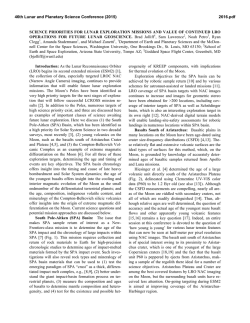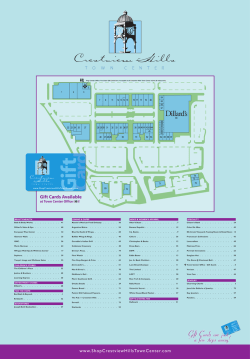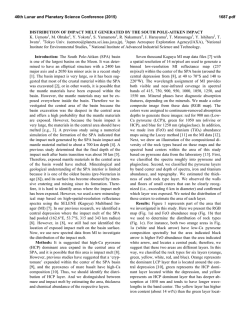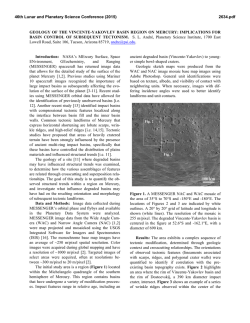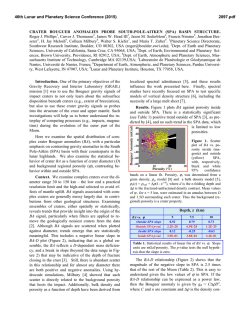
SPA-IMPACT ORIGIN FOR THE NEARSIDE DIKE SYSTEM ON THE
46th Lunar and Planetary Science Conference (2015) 2416.pdf SPA-IMPACT ORIGIN FOR THE NEARSIDE DIKE SYSTEM ON THE MOON. P. H. Schultz1 and D. A. Crawford2, 1Brown University, Providence, RI 02912 ([email protected]), 2Sandia National Laboratories, Albuquerque, New Mexico 87185, USA. Introduction: Gravity-gradient maps from the GRAIL mission reveal a network of deep feeder dikes encompassing much of the lunar nearside, generally around the Procellarum region [1]. Rather than an ancient impact basin, this system has been interpreted as a response to thermal contraction related to the cooling and thickening of the nearside lithosphere that resulted in extension along the margins. Here we propose instead that the SPA impact created extensive damage enabling this long-lived plumbing system. Background: In 1959, the Soviet Luna III first revealed that the lunar nearside differed dramatically from the farside, largely reflecting the nearside concentration of mare basalts. Ever since, various explanations have been proposed to account for the lunar dichotomy, e.g., differential dynamic effects [2] or the effects of a pre-Nectarian mega-impact basin [35]. The mega-basin model remains widely cited because it could account for the nearside concentration of the Procellarum KREEP Terrain (PKT). Alternatively, the nearside maria were controlled by the antipodal effects from formation of the SouthPole-Aitken Basin (SPA) [6]; however, the SPA antipode was far offset (NE of Imbrium) from the nearside center of the lunar mare concentrations (SW of Imbrium). Such an offset between the antipode of SPA and Procellarum could be resolved by an oblique trajectory for the SPA impactor, specifically from the NW [7]. Such a trajectory is consistent with the distribution of massifs surrounding SPA, the mapped distribution of pre-Nectarian units within SPA, and the concentration of Th-rich deposits (from the deepest zone uprange to the NW). Hence, this model proposed that the SPA collision created deep crustal failure leading to long-lasting deep feeder dikes and the nearside concentration of maria (and tectonic system). Gravity gradients from GRAIL Bouguer gravity anomalies now reveal a system of linear anomalies interpreted as remnants of deep feeder dikes encompassing a broad region of the lunar nearside [1]. Rather than a circular pattern related to an ancient nearside mega-basin, the linear anomalies form a quasi-rectangular pattern attributed to cooling and contraction formed in response to the formation of the PKT. This conclusion, however, still begs the question about the underlying cause for the distribution of the dikes. Consequently, we consider here the new GRAIL results in the context of the offset-antipodal effects from the SPA impact [7]. The Procellarum System: The SPA-Antipode (SPAA) model was initiated by the realization that sites of recent de-gassing occur along a concentric and system of graben, seemingly unaffected by large, later impacts [8]. Such a pattern required a deep-seated fracture system and was termed the Procellarum Fracture System (PFS), rather than the proposed Procellarum Basin. This terminology avoided the long-used terminology connoting an origin. The PFS includes a network of graben, igneous centers (e.g., Marius Hills, Rümker Hills), and sinuous-rille source regions along wrinkle ridges (e.g., Herigonius region), well away from basin-controlled eruptives. The radial system of graben overprint later forming impacts (e.g., Grimaldi, Humorum, and Imbrium) and radiate from a region now recognized as a topographic and gravity high southwest of the Imbrium basin. Such a system contrasts with the view that wrinkle ridges are only compression features in response to loading, especially where such ridges correlate with eruptive centers. SPA Origin of Nearside Intrusions: Laboratory experiments and numerical models demonstrated that a modestly oblique impact (30°) by a large (700 km diameter) asteroid would result in a massive failure encompassing much of the lunar nearside interior (to depths >800 km), centered on a region SW of the Imbrium basin [7]. The hydrocode model included a thermal of lunar interior around 4.3 Ga along with selfgravity. This model also revealed that more than 50% of the lunar interior would have been fractured with conditions of extension at depth (overcoming lithostatic overpressures) lasting more than 14 minutes (Fig. 1). Experiments and models also demonstrated that the greatest internal damage occurs antipodal to the first point of contact by the impactor, not the crater/basin. Moreover, it was proposed that the ridges and sinuous-rille source regions across much of the lunar nearside reflected igneous centers (dikes) initiated by the SPA impact, whereas the system of graben reflected peripheral extension in response to the load centered on the region with the greatest network of intrusions (southwest of Imbrium). The hydrocode model in [7] was not designed to delineate fracturing, but only damage regions where the failure criterion was met (extension and shear failure exceeding local conditions, e.g., overpressures at depth). Projections of calculated damage zones from depth to the surface encompassed a broad oblong region oriented NW/SE covering the lunar nearside (Fig. 2). This oblong pattern damage limit mirrors the extended asymmetric damage zone [9] and ejecta distribution [10] orthogonal to the trajectory of modestly oblique impacts. Rather than a “quasi- 46th Lunar and Planetary Science Conference (2015) rectangular” pattern of deep intrusions [1], it represents a “diamond-shaped” pattern that reflects widening of the damage zone perpendicular to the proposed trajectory. The greatest near-surface damage (<200 km) occurred closer to SPA (Fig. 1), resulting in a more extensive arcuate network of intrusions in southwest Procellarum (Fig. 2). The region with the least damage occurs farthest from the first contact (NE of Imbrium), along the trajectory where the feeder dikes become more rectilinear. It is also noted that floor-fractured craters, FFC’s [11,12] are generally localized along the inferred feeder dikes with the greatest concentration along the western edge of Oceanus Procellarum [11]. Floorfractured craters were proposed to represent impactdamage zones that later localized intrusions from deepseated fractures as the lunar interior heated up, well after accretion. FFC’s tend to be larger (and less modified) farther from western edge of Procellarum [12] and may indicate the need for deeper fracturing in order to tap into the ancient plumbing system. Hence, we propose that the SPA impact established the network of weaknesses that later controlled the distribution of PKT-Th within Procellarum. Much of the PKT-Th concentrations would have remained buried, had it not been for later excavation by the Imbrium impact. The oblique trajectory for Imbrium from the NW exposed greater amounts PKT-Th centered to the SW of Imbrium (I in Fig. 1). )*+,-./0#$ !"!#$ !"!"$ !"%$ !"&$ '!"&$ '!"%$ '!"($ Figure 1: Extension (beyond lithostatic overpressures) created by the shocks converging on the antipodal region from the 700km-diameter SPA asteroid impacting the Moon at 30°. The oblique trajectory induces the greatest damage antipodal to the first point of contact (500 sec after impact) and is proposed to create conditions for magma localization beneath the lunar nearside. Most of the damage occurs below the Oceanus Procellarum (OP) region, extending to one side of the Imbrium basin. (I). 2416.pdf Figure 2: Deep feeder dikes (blue) inferred from GRAIL gravity data [1] superimposed on a system of graben (red lines) and ridges (black lines) comprising the Procellarum System (PS) of tectonic features on the lunar nearside along with calculated subsurface damage from the SPA impact [7]. The red-hued region corresponds to damage at a depth (800 km) that was created by the SPA basin extrapolated to the surface (Fig. 1) and encompasses the limits of the PS and the feeder dikes. The deep feeder dikes are proposed to be the result of long-lasting SPA-induced fracturing in the deep crust. The first contact by the SPA impactor and the basin center are also shown (transparent Moon), along with their respective antipode locations projected on the nearside. The greatest damage is antipodal to the first contact, offset from the final basin center. The proposed trajectory of the SPA impactor is indicated by the great circle. References: [1] Andrews-Hanna, J. C. et al. (2013), Science 339, 675-678; [2] Zhong et al. (2000), Earth and Planet. Sci. Letts., 177, 131–140; [3] Cadogan P. H. (1974) Nature 250, 315-316; [4] Whitaker E. A. (1980) in Multi-ring Basins: Formation and Evolution, LPI, 105-111; [5] Jutzi, M. and Asphaug, E. (2011), Nature 476, 69–72; [6] Garrick-Bethell, I., and Zuber, M.T. (2009), Icarus, v. 204, p. 399–408; [7] Schultz P. H. and Crawford, D. A. (2011), Geol. Soc. of Amer. Sp. Paper 477, p. 141-159; [8] Schultz, P. H. et al. (2006), Nature, v. 444, no. 7116, p. 184–186; [9] Schultz, P. H. and Anderson, R. A. (1996), Geol. Soc. of Amer. Sp. Paper 302, p. 397–417; [10] Anderson, J. A. (2003), J. Geophys. Res. 108, no. E8, 5094; [11] Schultz, P. H. (1976), The Moon 15, 241-273; [12] Jozwiak, L. M. et al. (2012), J. Geophys. Res. 117, E11005.
© Copyright 2026

